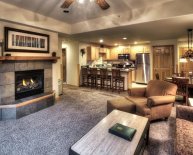
Country Boy Mine Breckenridge
This is the sixth and final part in a six-part series about the history of the ski run names at Breckenridge Ski Resort. To read the first five parts, visit .
The Peak 9 ski area at Breckenridge Ski Resort first saw the light of day in the 1971-72 season and was originally named Royal Tiger Mountain. Royal Tiger was named after the Royal Tiger Mines Co., a local mining operation formed in 1921. Over a 15-year period, Royal Tiger came to own most of the mining properties in French Gulch and the Swan River area before it went bankrupt in the mid-1930s.
The original lifts, in a stunning flash of imagination, were named "A" and "B, " with "C" added in 1972. Lift A — the lower portion of which was originally located near the current Quicksilver lift — and C are still with us, moseying their way slowly up the mountain. "D, " "E, " and "F" were added in later years (not all on Peak 9), and F became what is now called the Falcon SuperChair on Peak 10 in 1985.
While the original lift names had no historical meaning, many of the Peak 9 runs were taken straight out of local history. Wellington was named after the largest mine in the Breckenridge area; it opened in the 1880s and finally closed in 1972. It was a silver, lead and zinc mine in French Gulch and was vital during World War II for its high-grade zinc ore. The nearby Country Boy is named after the Country Boy Mine, still in operation as a tourist attraction in French Gulch. Country Boy also opened in the 1880s and, along with the Wellington, was a valuable producer of high-grade zinc during World War II.
Silverthorne was named after one of the more colorful figures in Breck history — Judge Marshall Silverthorn, an 1860s prospector who soon learned that "mining the miners" was far more lucrative than mining itself. He opened the Silverthorn Hotel on the site of the current Downstairs at Eric's, owned at least one mining supply store and became a judge. Despite his pint size, he was known for his fiery disposition, outspokenness and fairness. Note the spelling — the current town of Silverthorne (as well as the ski area) adopted its version of the judge's name, thinking that the "e" on the end added "class" to the name.
Cashier was also one of the original runs, named after the silver, lead and zinc Cashier Mine in Browns Gulch in the Swan River area, and active from the 1880s to the early 1970s. It was very close to Swan City, an early gold mining camp whose namesake ski run is on Peak 7. Gold King was a large, local placer gold claim, while Lehman was named after Lehman Creek, which, in turn, was probably named after an early prospector in the area.
Mining and Mercury
Two of the three current lifts on Peak 9 have mining-related — or seemingly related — names. Quicksilver (not given that name until the 1986-87 season) is an informal term, or nickname, for mercury, a silvery, metallic liquid element used in an early gold recovery process called retorting. Mercury "dissolved" gold and silver flakes, then was boiled off to recover the precious metals. This was before anyone knew that mercury vapor is highly, highly toxic.
The Mercury lift might seem to be a convenient link to our mining past, as well. However, the lift (which was originally located where the current-day Beaver Run lift is located) was named after the Mercury space program of the early 1960s. Mercury astronauts Alan Shepard, John Glenn, Scott Carpenter and Gordon Cooper were the opening ceremony's guests of honor in 1990, due possibly to a personal connection between the space program and the then ski area marketing manager Dave Peri.
Several other runs are named after early local silver, lead or zinc mines. Briar Rose was also an 1880s mine and is visible on the north slopes of Peak 10 from its namesake run on Peak 9. Union is also named after a mine complex — the Union Mine and Mill in French Gulch.
Fiery backside of Peak 9
How about the fiery "hell" theme on the backside of Peak 9? No real connection to local history but a couple of good stories: Ski-area management in the mid-1970s wanted some catchy names for the very steep new area, the steep road to hell was the way it was expressed. Local skiers, and perhaps the ski patrol, had long called a steep chute in the area Devil's Crotch. The "Crotch" was pretty "catchy" and the meanest name the patrol could think of in line with the "hell" theme — at least for a family ski area.
One run was named Inferno, but little did management know that the area would soon live up to its name. During the cutting of the run in 1975, the trail crew was burning slash from the cutting operation when a drum of diesel fuel rolled into the fire, igniting its own inferno. Hades and Purgatory round out the theme in the area. Speaking of the ski patrol, they received an honor in about 1990 when Volunteer was named in honor of what was then a volunteer corps of dedicated safety patrollers at Breck.













